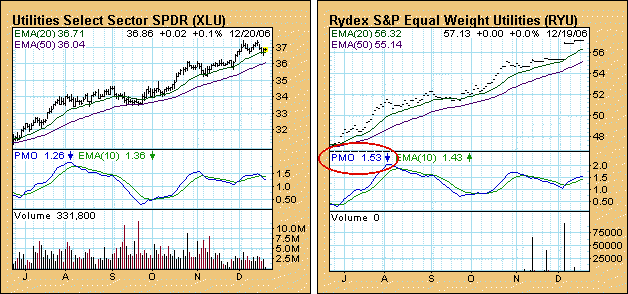New Equal Weight Sector ETFs
In November, nine new equal weight sector ETFs began trading.
They are sponsored by Rydex, and they are counterparts to the original nine
Sector Spiders that are composed of the stocks in the S&P 500 Index. I have been
a long-time and enthusiastic advocate of equal weighted indexes because they
truly allow you to spread your risk equally among all the stocks in the index,
and I am very pleased to see these newest trading vehicles become available.
Let’s take a moment to explain what an equal weighted index is.
Most market/sector indexes are weighted by capitalization, which means that the
largest cap stocks exert the most influence on the price movement of the index.
For example, I once examined the S&P 500 Index and found that the top 50 stocks
(ranked by market cap) actually represented about 70% of the entire S&P 500.
What this means is that the remaining 450 stocks have very limited influence on
the index.
In the case of these new equal weighted sector ETFs, each stock in the sector is
initially given an equal weight in the index, and re-balancing takes place on a
quarterly basis.
In addition to avoiding overexposure to the larger-cap stocks in the index,
equal weight indexes usually perform better than their cap-weighted
counterparts. This is because the smaller-cap stocks, which usually perform
better than larger-cap stocks, have a heavier weight in the index.
In the charts below I have arranged the nine sectors in alphabetical order. The
regular Spiders are on the left, and the equal weight ETF versions are to their
right for comparison. The PMO (Price Momentum Oscillator) is one way to measure
relative strength — higher numbers reflecting higher strength. I have circled
the highest of the two PMOs in red. Note that eight of the nine equal weight
ETFs are stronger than their cap-weighted Spider counterparts.
I should note that we have constructed simulated data for several years prior to
the time the new ETFs started trading in November. These data were adapted from
back calculations of the sector indexes, and they should be a fairly accurate
calculation of how the equal weight sectors ETFs would have actually performed.
This simulated data will allow us to make intelligent technical trading
decisions without having to wait for actual data to accumulate.





The new ETFs are currently very thinly traded, but this should change as soon as
they have been “discovered”.
Carl Swenlin is a self-taught technical analyst, who has been
involved in market analysis since 1981. A pioneer in the creation of online
technical resources, he is president and founder of
DecisionPoint.com, a premier
technical analysis website specializing in stock market indicators, charting,
and focused research reports. Mr. Swenlin is a member of the
Market Technicians Association.
